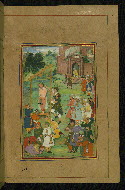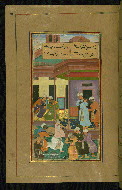Home > Digitized Walters Manuscripts
This document is a tranformation of a TEI P5 XML manuscript description incorporating images. If you have trouble reading special or non-Latin characters on this page, please make sure you have appropriate Unicode fonts installed and an up-to-date web browser.
Walters Ms. W.650, Collection of poems (divan)
Browse images (Browse images in a new window) | TEI in XML format
W.650
Collection of poems (divan)
Vernacular: ديوان حسن
Authority name: Ḥasan Dihlavī, 1253 or 4-ca. 1338
As-written name: Amīr Najm al-Dīn Ḥasan Dihlavī
Name, in vernacular: امير نجم الدين حسن دهلوى
Note: Author dates preferred by cataloger: d. ca. 729 AH / 1328 CE
This is an illuminated and illustrated Mughal copy of a collection of poems (dīvān) by the eminent poet and hagiographer of Islamic India, Ḥasan Dihlavī (d. ca. 729 AH / 1328 CE). It was written in nastaʿlīq script by ʿAbd Allāh Mushkīn Qalam (Amber-Scented Pen) in Allāhābād in 1011 AH / 1602 CE, according to the colophon on fol. 187a. A celebrated royal calligrapher, Abd Allāh Mushkīn Qalam worked in Allāhābād for Prince Salim, who later became the Mughal Emperor Jahāngīr. The manuscript opens with a double-page illuminated incipit (fols. 2b-3a) and is illustrated with fourteen paintings, including a portrait of the calligrapher himself (fol. 187a). The lacquer binding has intricate all-over illumination in which the main element is a pattern of gold strapwork with floral motifs, attributable to the thirteenth century AH / nineteenth century CE.
27 Muḥarram 1011 AH / 1602 CE (see fol. 187a, illustration)
Allāhābād, India
As-written name: ʿAbd Allāh Mushkīn Qalam
Name, in vernacular: عبد الله مشكين قلم
Known as: Mir `Abd Allah Katib
Note: The colophon gives the name of the calligrapher as ʿAbd Allāh Mushkīn Qalam (the Musky Pen or Amber-Scented Pen). However, the illustration (on the same page) gives the calligrapher as Mīr ʿAbd Allāh Kātib. Mīr ʿAbd Allāh was a well-known court calligrapher of the Mughal Emperor Jahāngīr. He was the father of Muḥammad Ṣāliḥ (Kambūh), the author of one of the major histories of Shāh Jahān’s reign, the Amal-i Ṣāliḥ, also known as Shāh Jahānnāmah (The history of Shah Jahan).
Book
Literary -- Poetry
The primary language in this manuscript is Persian.
- Transliteration: katabahu [al-mudh] nib al-ḥaqīr ʿAbd Allāh Mushkīn Qalam /1/ [gh]afara Allāh dhunūbahu wa-satara Allāh ʿuyūbahu /2/ sanah 1011 /3/
- Comment: Gives the name of the calligrapher as ʿAbd Allāh Mushkīn Qalam and the date 1011 AH / 1602 CE
Paper
Biscuit-colored laid paper
Foliation: i+189
Both pagination (370 pages) and foliation (185 folios) given in Hindu-Arabic numerals, the foliation appearing in the lower left corner of the frame
20.5 cm wide by 31.5 cm high
10.5 cm wide by 20.0 cm high
- Columns: 2
- Ruled lines: 14
- Framing lines in blue, black, gold, and red
- Title: Dīvān-i Ḥasan
- Author: Ḥasan Dihlavī, 1253 or 4-ca. 1338
- Scribe: ʿAbd Allāh Mushkīn Qalam
- Incipit: اى رقم رانده بر سبيد وسياه...
- Hand note: Written in black nastaʿlīq script
- Decoration note: Fourteen illustrations, the captions for which were supplied by a later hand on fol. 1b; double-page illuminated incipit (fols. 2b-3a); cloud-bands; border with floral design
Upper board outside:
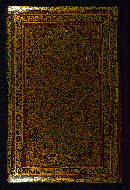
- Title: Binding
- Form: Binding
- Label: This lacquer binding has fine and intricate illumination in which the main element is a pattern of gold strapwork and floral scrolls. It is attributable to the thirteenth century AH / nineteenth century CE.
fol. 2b:
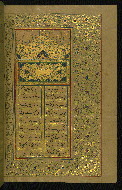
- Title: Double-page illuminated incipit
- Form: Incipit; headpiece
- Label: This double-page illuminated incipit is decorated with a headpiece, cloud-bands, and a border with floral design.
fol. 3a:
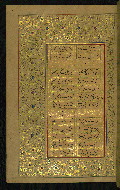
- Title: Double-page illuminated incipit
- Form: Incipit
- Label: This double-page illuminated incipit is decorated with interlinear decoration and a wide border of floral motifs.
fol. 15a:
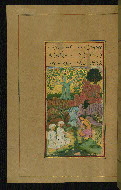
- Title: Majnūn in the wilderness being counseled by his father to abandon his love for Laylá and return home
- Form: Illustration
- Label: This illustration is attributed to Mīrzā Ghulām.
fol. 22b:
fol. 32b:
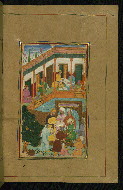
- Title: Joseph being sold at the entrance to the bazaar
- Form: Illustration
- Label: This illustration is attributed to Mīrzā Ghulām.
fol. 41a:
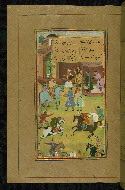
- Title: A game of polo
- Form: Illustration
- Label: This illustration is identified by some scholars as involving Prince Salīm, the future Emperor Jahāngīr.
fol. 48a:
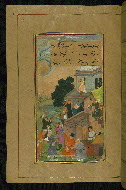
- Title: A gathering of men
- Form: Illustration
- Label: This illustration depicts a gathering of men admiring the moon in the sky, including the poet, who instead admires the beauty of a girl on the roof.
fol. 62a:
fol. 84b:
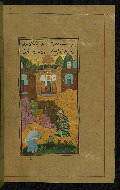
- Title: Farhād being approached by an old woman with the false news of Shīrīn’s death
- Form: Illustration
- Label: This illustration is attributed to Mīrzā Ghulām.
fol. 109b:
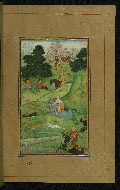
- Title: A hunting scene
- Form: Illustration
- Label: This illustration is identified by some scholars as involving Prince Salīm, the future Emperor Jahāngīr.
fol. 113a:
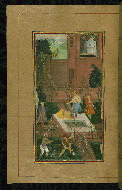
- Title: A garden scene with a man (probably the poet himself) kissing the prince's feet
- Form: Illustration
fol. 127a:
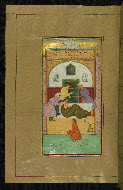
- Title: A sick man being attended to by a physician
- Form: Illustration
- Label: This illustration is attributed to Mīrzā Ghulām.
fol. 140a:
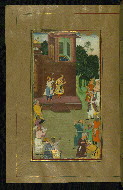
- Title: A prince with a flower being paid homage by his courtiers, including the poet himself
- Form: Illustration
fol. 157a:
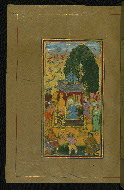
- Title: King Solomon enthroned in the company of demons, angels, birds, and animals
- Form: Illustration
- Label: This illustration is attributed to Mīrzā Ghulām.
fol. 184b:
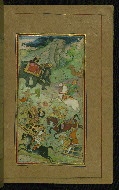
- Title: A battle scene
- Form: Illustration
- Label: According to the description on fol. 1b, this scene features Muḥammad Shāh of India.
fol. 187a:
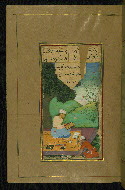
- Title: Portrait of the scribe Mīr ʿAbd Allāh Kātib in the company of a youth burnishing paper
- Form: Illustration
- Label: This illustration is attributed to Nānhā by Stuart C. Welch. The scribe holds a piece of paper giving his name, the place of copying (Allāhābād), and the date 27 Muḥarram 1011 AH / 1602 CE.
The binding is not original.
Attributable to the thirteenth century AH / nineteenth CE; lacquer boards (no flap); geometrical and floral design in the main panel
Walters Art Museum, 1931, by Henry Walters bequest
Beach, Milo Cleveland. The Grand Mogul: Imperial Painting in India, 1600-1660. (Williamstown, Mass: Sterling and Francine Clark Art Institute, 1978), 34.
Das, Asok Kumar. Splendour of Mughal Painting. (Bombay: Vakils, Feffer, and Simons, 1986), 24, pl. III.
Losty, Jeremiah P. The Art of the Book in India. (London: British Library, 1982), 94.
Richard, Francis. Catalogue des manuscrits persans. (Paris: Bibliothèque nationale, 1989), nos. 282-3.
Seyller, John. "The Walters Art Museum Diwan of Amir Hasan Dihlawi and Salim's Atelier at Allahbad." in Arts of Mughal India: Studies in Honour of Robert Skelton (London: Victoria and Albert Museum, 2004), 95-110.
Ettinghausen, Richard. Paintings of the Sultans and Emperors of India in American Collections. (New Delhi: Lalit Kalā Akademi, 1961), pl. 8.
Principal cataloger: Gacek, Adam
Catalogers: Landau, Amy; Smith, Sita
Editor: Bockrath, Diane
Conservators: Jewell, Stephanie; Quandt, Abigail
Contributors: Barrera, Christina; Emery, Doug; Herbert, Lynley; Noel, William; Simpson, Shreve; Tabritha, Ariel; Toth, Michael B.; Valle, Chiara
The Walters Art Museum
Licensed for use under Creative Commons Attribution-NonCommercial-ShareAlike 3.0 Unported Access Rights, http://creativecommons.org/licenses/by-nc-sa/3.0/legalcode. It is requested that copies of any published articles based on the information in this data set be sent to the curator of manuscripts, The Walters Art Museum, 600 North Charles Street, Baltimore MD 21201.
